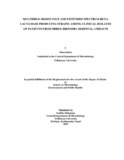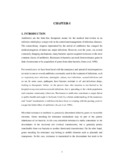Please use this identifier to cite or link to this item:
https://elibrary.tucl.edu.np/handle/123456789/614| Title: | Multidrug Resistance Andextended Spectrum Beta-Lactamaseproducing Strains Among Clinical Isolates of Patients From Shree Birendra Hospital, Chhauni |
| Authors: | Maharjan, Sushila |
| Keywords: | Urine;Sputum;Pus |
| Issue Date: | 2010 |
| Publisher: | Central Department of Microbiology |
| Institute Name: | Central Department of Microbiology |
| Level: | Masters |
| Abstract: | Themicrobial resistance to various classes of drugs has increased a multitude of bacterialspecies which has complicated the therapeutic management of infections. For this reason, asix month study was conducted in order to analyze the prevalence of the Multidrug Resistant strains(MDR) and the Extended Spectrum of -lactamase(ESBL) producingstrains among the organisms, isolated from clinical specimens (urine, sputum and pussamples) received in the laboratory. Microorganisms from 388 clinical specimens wereidentified by conventional microbiological method and antimicrobial susceptibility ofbacterial isolates was determined byCLSI (Clinical and Laboratory Standard Institute)recommended by Kirby-Bauer method.Among 388 clinical samples processed in the study,207 were urine samples, 79 were sputum samples and 102were pus samples. Out of 207urine samples, 95 (45.89%) showed significant growth and among the 95 isolates, 62(65.26%) were multi-drug resistant. In urine sample, Escherichia coli was the mostpredominant Gram-negative isolate. Out of 68E. coli isolates, 47 (69.12%) were found tobe MDR and 11 (16.18%) were ESBL-producers. Out of 79 sputum samples received, 77(97.47%) met the American Society for Microbiology (ASM) criteria and thus wereconsidered for further processing, whereas 2 (2.53%) of the samples didn’t meet the criteriaand were not included in this study. Out of 77 processed sputum samples, 20 (25.97%)samples showed significant growth, out of which, 9 (45%) were MDR and 3 isolates ofKlebsiella pneumoniaeamong 20 different isolates from the sputum samples were ESBL-producers. Likewise, out of 102 pus samples, 75 (73.53%) showed significant growth with82 isolates (some samples showed more than one type of significant bacterial growth) andamong 82 isolates, 40 (39.22%) were multi-drug resistant, additionally, 5 isolates (3 out of23 isolates ofEscherichia coliand 2 out of 8 isolates ofKlebsiella pneumoniae) were foundto be ESBL-producers. In all the urine and pus specimens, the most predominant Gram-negative isolate was Escherichia coli while in case of sputum, it was Pseudomonasaeruginosa. The most predominant Gram-positive isolates wereStaphlococcus aureusin allthe studied specimens. Erythromycin and cloxacillin were highly effective towards Gram-positive isolates, nitrofurantion towards Gram-negative urinary pathogens while gentamicinfollowed by ciprofloxacin and amikacin for sputum and pus isolates. Thus total of 386samples were processed, out of which 190 (49.22%) samples showed positive growth with197 (51.03%) of total isolates and among those bacterial isolates, 111 (57.21%) were foundto be MDR-strains whereas 19 of them were found to be ESBL-producers. Significantassociation was found between multidrug resistance and hospitalization of patients indifferent wards (P<0.05), whereas no association was seen between multidrug resistanceand gender (P>0.05). Key words: Urine, Pus, Sputum, ASM, MDR, ESBL, DDST |
| URI: | http://elibrary.tucl.edu.np/handle/123456789/614 |
| Appears in Collections: | Microbiology |
Files in This Item:
| File | Description | Size | Format | |
|---|---|---|---|---|
| COVER.pdf | 56.05 kB | Adobe PDF |  View/Open | |
| CHAPTER.pdf | 562.15 kB | Adobe PDF |  View/Open |
Items in DSpace are protected by copyright, with all rights reserved, unless otherwise indicated.
